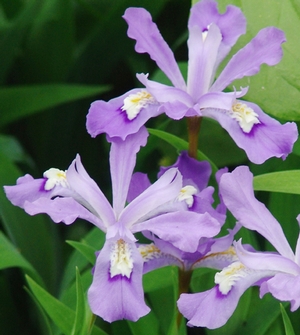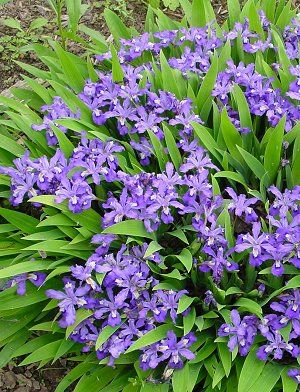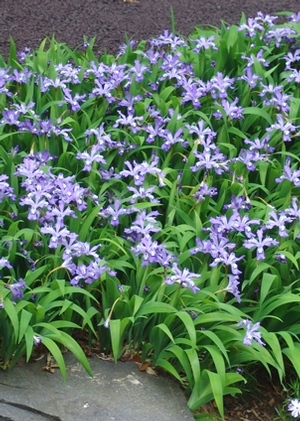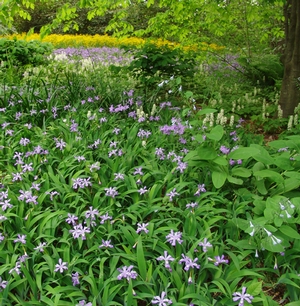Iris cristata
Common: dwarf crested irisIris cristata - 50 per flat
- Height: 6"-8"
- Spread: 15"
- Spacing: 12"
- Hardiness Zone(s): 5-8


Iris cristata - 50 per flat



Blue-violet flowers appear in early spring, carpeting the native woodland garden or shaded perennial border. Will naturalize, spreading to form a beautiful native groundcover.
Prefers rich, well-drained soils in full to partial shade. If grown in full sun, the soil must remain consistently moist. Benefits from the addition of lime and rich, organic materials. Is rhizomatous and can be propagated by division after flowering is done with a sharp spade or pulling apart entangled rhizomes (which actually give rise to healthier plants). Best used as a seasonal groundcover, in rock gardens, or added for woodland color.
The colorful blooms and easy culture of dwarf crested iris make it a valuable addition to the shady native woodland garden. In mid-spring, this attractive perennial groundcover is a mass of pale to deep violet blooms that reach 4-6” in height. Its 5-6” sword-like leaves arise from small rhizomes, that quickly spread, to form impressive colonies with a unique textural quality. Iris cristata does well in average, well-drained woodland soils in shade to partial shade and, once established, is dependably drought-tolerant. It complements other woodland plants such as Phlox divaricata, Uvularia sessilifolia, Geranium maculatum, Hydrastis canadensis, and Trillium luteum. - Mt. Cuba Center
A diminutive plant just six inches tall, this woodland beauty blooms in April on shady hillsides from Maryland south to Georgia and west to Louisiana. The leaves are short, broad and strap-like, bending over near the tips. The flowering stem is sheathed by the over-lapping leaves which grow finally to about a foot high. The stubby rhizomes are connected by slender runners.
The sepals, sometimes called "the falls", are bluish to lavender with a conspicuous splotch of orange and white at the base (the crest). The smaller petals (the standards) are uniformly bluish to lavender. - Auburn.edu
The iris was said to have first been adopted as an emblem in the 6th century by King Clovis of the Franks, after a clump of yellow flag iris had shown him where he could ford a stream and escape a superior force of Goths. It was revived as an emblem, the Fleur-de-Louis, in 1147 when Louis VII of France set off on the ill-fated second crusade. The emblem has been used since 1180 as a badge of the kings of France, and although referred to as the "Lily of France," was probably I. pseudocorus. The iris has been adopted by many kings since and has represented the birth of Christ in many classical paintings. Not to be outdone, even the Canadian Province of Quebec uses the Fleur-de-lis on her provincial flag. Countries of the world seem unabashedly attached to the beauty of the iris and in any one garden, English, Spanish, Dutch, Persian, German, Californian, Japanese, Lousiana, Pacific Coast, and Siberian irises may be found. - Herbaceous Perennial Plants, Allan Armitage